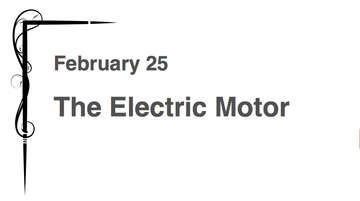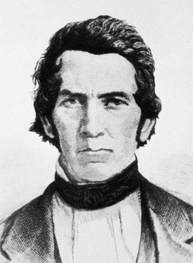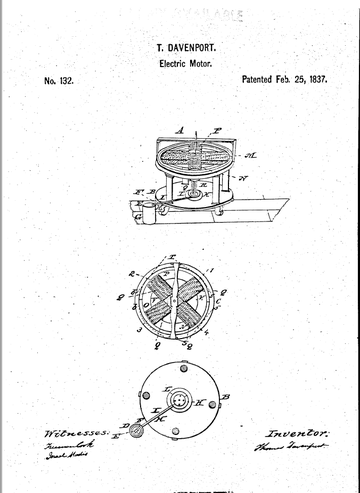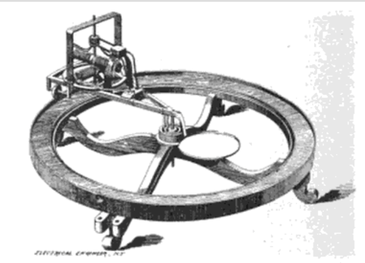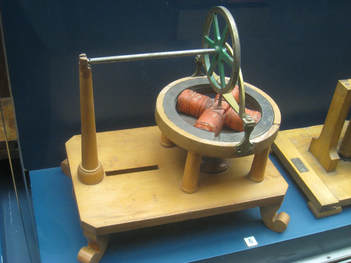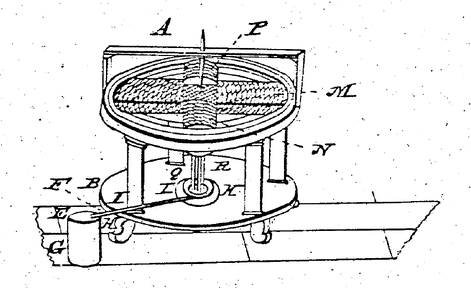 Davenport Motor
Davenport Motor
On February 25 of the year 1837, U.S. Patent No. 132 issued to Thomas Davenport for "Improvement in Propelling Machinery by Magnetism and Electro-Magnetism ". It was the first patent in the world for an electric motor. Indeed, it may be the first patent in the world for an electrical device. Whether Davenport was the first to build an electric motor, however, is still open to debate. Other contenders for that honor include the Hungarian priest, Ànyos Jedlik, the German-Russian, Moritz Hermann von Jacobi, the Englishman, William Sturgeon, and the two Dutchmen, Sibrandus Stratingh and Christopher Becker. From the historical record, it is difficult to ascertain with any certainty who was first.
Davenport was a poor blacksmith in Brandon, Vermont, who had no formal education, but was highly curious and a passionate reader. Davenport first became interested in electromagnetism when he heard about a new process that was being used at an iron works in nearby Ironville, New York to separate iron from ore using magnetism. The process used magnetized iron bars mounted on a wooden drum that was rotated in a trough containing crushed ore. As the drum rotated, iron particles adhered to the magnetized iron bars and were lifted out of the trough, where they were removed by stationary brushes.
The iron bars were magnetized by a large electromagnet built by Joseph Henry, the noted scientist, who discovered the electromagnetic phenomenon of self-inductance and would later become the first Secretary of the Smithsonian Institution. Henry's electromagnet was formed from insulated wire that was wrapped around a soft iron core and connected to a galvanic battery. The ore separation process at Ironville, using Henry's electromagnet, was the first industrial use of electricity in history.
After witnessing the ore separation process at Ironville in 1833, Davenport, with the help of family, raised $75 and purchased one of Henry's electromagnets from the iron works. With the assistance of his wife, Emily, Davenport dismantled the electromagnet to see how it worked. He then built two electromagnets of his own design, and soon thereafter, built his first electric motor. Since Davenport did not have access to insulated wire, Emily Davenport cut up her wedding dress into strips of silk that were used to insulate the wire for the electromagnets.
The electric motor built by Davenport had a frame formed by an upper ring connected by vertical posts to a lower disc. A pair of crescent-shaped "artificial" (permanent) magnets were mounted to the upper ring. An electromagnetic structure was rotatably mounted radially inward from the artificial magnets. The electromagnetic structure was comprised of four electromagnets arranged in an X configuration and mounted to a wooden wheel, which was secured to a rotatable shaft. Below the electromagnetic structure, a pair of crescent-shaped copper plates were mounted to the lower disc of the frame. The copper plates were separated from each other and arranged around the rotatable shaft. The copper plates were respectively connected by wires to copper and zinc plates of a galvanic battery, i.e., positive and negative terminals of the battery. Fixed wires from the electromagnets extended vertically downward to the copper plates on the lower disc and made (non-fixed) contact with them. When current from the battery was supplied to electromagnets, the electromagnetic structure would rotate, with the polarity of the electromagnets changing during their revolution as a result of the alternating (wiping) contact of the vertical wires with the (positive and negative) copper plates.
After successfully constructing his electric motor in July of 1834, Davenport filed a patent application for his invention. Remarkably, the application was rejected, most likely because the Patent Office had not seen anything like Davenport's motor before and did not understand its operation. Undeterred, Davenport proceeded to get testimonials and letters of support from leading scientists and academics. He also made public demonstrations of his invention, including displaying a model electric railroad that he had built using his motor. Most importantly, however, Davenport obtained financial and technical support from another inventor, Ransom Cook. With the help of Cook, Davenport built an improved model of his motor and then headed off to the Patent Office, where he filed a second patent application for his electric motor in the late fall of 1836. Davenport hoped that the letters of support and the new model would convince the Patent Office to issue him a patent. Unfortunately, Davenport's timing could not have been worse.
On December 15, 1836, the Patent Office caught fire and was mostly destroyed. The fire consumed over 7,000 patent models and most of the files of pending patent applications and issued patents. Included in this loss was Davenport's second patent application and new model. Davenport, however, did not give up. He built another model (shown below) and resubmitted his patent application. This time, he was successful and was awarded Patent No. 132 for his electric motor.
While Davenport received a patent, he did not obtain commercial success for his motor. The batteries of the day were too unreliable and difficult to properly size for a particular application. As such, a battery-powered electrical motor could not compete with a steam engine. Electric motors would not become practical for another twenty years when a constant, reliable source of electricity could be obtained from a dynamo, which was essentially an electric motor run in reverse. As with many other inventors, Davenport was too far ahead of his time. He was never able to enjoy the fruit of his technical success. He died penniless in 1851 at the age of 49.
Davenport was a poor blacksmith in Brandon, Vermont, who had no formal education, but was highly curious and a passionate reader. Davenport first became interested in electromagnetism when he heard about a new process that was being used at an iron works in nearby Ironville, New York to separate iron from ore using magnetism. The process used magnetized iron bars mounted on a wooden drum that was rotated in a trough containing crushed ore. As the drum rotated, iron particles adhered to the magnetized iron bars and were lifted out of the trough, where they were removed by stationary brushes.
The iron bars were magnetized by a large electromagnet built by Joseph Henry, the noted scientist, who discovered the electromagnetic phenomenon of self-inductance and would later become the first Secretary of the Smithsonian Institution. Henry's electromagnet was formed from insulated wire that was wrapped around a soft iron core and connected to a galvanic battery. The ore separation process at Ironville, using Henry's electromagnet, was the first industrial use of electricity in history.
After witnessing the ore separation process at Ironville in 1833, Davenport, with the help of family, raised $75 and purchased one of Henry's electromagnets from the iron works. With the assistance of his wife, Emily, Davenport dismantled the electromagnet to see how it worked. He then built two electromagnets of his own design, and soon thereafter, built his first electric motor. Since Davenport did not have access to insulated wire, Emily Davenport cut up her wedding dress into strips of silk that were used to insulate the wire for the electromagnets.
The electric motor built by Davenport had a frame formed by an upper ring connected by vertical posts to a lower disc. A pair of crescent-shaped "artificial" (permanent) magnets were mounted to the upper ring. An electromagnetic structure was rotatably mounted radially inward from the artificial magnets. The electromagnetic structure was comprised of four electromagnets arranged in an X configuration and mounted to a wooden wheel, which was secured to a rotatable shaft. Below the electromagnetic structure, a pair of crescent-shaped copper plates were mounted to the lower disc of the frame. The copper plates were separated from each other and arranged around the rotatable shaft. The copper plates were respectively connected by wires to copper and zinc plates of a galvanic battery, i.e., positive and negative terminals of the battery. Fixed wires from the electromagnets extended vertically downward to the copper plates on the lower disc and made (non-fixed) contact with them. When current from the battery was supplied to electromagnets, the electromagnetic structure would rotate, with the polarity of the electromagnets changing during their revolution as a result of the alternating (wiping) contact of the vertical wires with the (positive and negative) copper plates.
After successfully constructing his electric motor in July of 1834, Davenport filed a patent application for his invention. Remarkably, the application was rejected, most likely because the Patent Office had not seen anything like Davenport's motor before and did not understand its operation. Undeterred, Davenport proceeded to get testimonials and letters of support from leading scientists and academics. He also made public demonstrations of his invention, including displaying a model electric railroad that he had built using his motor. Most importantly, however, Davenport obtained financial and technical support from another inventor, Ransom Cook. With the help of Cook, Davenport built an improved model of his motor and then headed off to the Patent Office, where he filed a second patent application for his electric motor in the late fall of 1836. Davenport hoped that the letters of support and the new model would convince the Patent Office to issue him a patent. Unfortunately, Davenport's timing could not have been worse.
On December 15, 1836, the Patent Office caught fire and was mostly destroyed. The fire consumed over 7,000 patent models and most of the files of pending patent applications and issued patents. Included in this loss was Davenport's second patent application and new model. Davenport, however, did not give up. He built another model (shown below) and resubmitted his patent application. This time, he was successful and was awarded Patent No. 132 for his electric motor.
While Davenport received a patent, he did not obtain commercial success for his motor. The batteries of the day were too unreliable and difficult to properly size for a particular application. As such, a battery-powered electrical motor could not compete with a steam engine. Electric motors would not become practical for another twenty years when a constant, reliable source of electricity could be obtained from a dynamo, which was essentially an electric motor run in reverse. As with many other inventors, Davenport was too far ahead of his time. He was never able to enjoy the fruit of his technical success. He died penniless in 1851 at the age of 49.
Proudly powered by Weebly


